RBSE Solutions for Class 6 Science Chapter 14 Electric Circuits are part of RBSE Solutions for Class 6 Science. Here we have given Rajasthan Board RBSE Class 6 Science Chapter 14 Electric Circuits.
| Board | RBSE |
| Textbook | SIERT, Rajasthan |
| Class | Class 6 |
| Subject | Science |
| Chapter | Chapter 14 |
| Chapter Name | Electric Circuits |
| Number of Questions Solved | 38 |
| Category | RBSE Solutions |
Rajasthan Board RBSE Class 6 Science Chapter 14 Electric Circuits
Intext Questions
Question 1.
Make a list of the places where we use an electric cell. (Page 118)
Answer:
In the following appliances we use electric cell, e.g.,
- radio
- electric torch
- calculator
- remote controls of TV
- watches
- Mobile phone
- Automatic toys of kids.
Question 2.
Differentiate the bulb used in homes with the bulb used in torch. What are the similarities between the two. (Page 119)
Answer:
Both have bulb of glass, filament and positive and negative terminals. Both produce light.
Question 3.
Sometimes we see that even in a complete electric circuit the bulb does not glow. What is the cause of it? (Page 119)
Answer:
It only happens when the connection of the circuit is not complete or the wire are not properly connected or the bulb is damaged.
Question 4.
Differentiate between working bulb and fused bulb. (Page 119)
Answer:
Working bulb has filament of proper wire, while, damaged bulb has filament of broken wire.
Question 5.
How a switch works? (Page 119)
Answer:
A switch close and open the circuit, When switch is on, then current flows in the circuit and when switch is off, then circuit is open and current does not flow.
Question 6.
Can electricity flow through all type of substances? (Page 120)
Answer:
No, electricity can flow only through conductors. Electricity cannot flow through insulators.
Activities
Activity – 2 (Page 119)
1. Take a cell and an electric bulb.
2. Take two electric wires of different colours of 10 cm each.
3. Remove the plastic coverings from the ends of the wires and join the wires with the help of insulating tape.
4. In figure
(a) the bulb is glowing but in figure
(b) the bulb is not glowing.
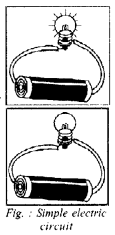
Question 1.
Why does this happen ? Discuss.
Answer:
In figure
(b) the terminals are connected wrong. Bulb will glow when red wire connected to positive terminal of cell and black wire connected to negative terminal of cell.
Exercises
Choose the correct answer from the following
Question 1.
The number of terminal (s) in an electric cell are
(a) one
(b) two
(c) three
(d) none of these
Answer:
(b) two
Question 2.
Through which of the following, electricity does not flow
(a) copper
(b) iron
(c) wood
(d) aluminium
Answer:
(c) wood
Question 3.
Which of the following is used to make electric wires?
(a) wood
(b) copper
(c) plastic
(d) thread
Answer:
(b) copper
Question 4.
Which of the following does not run on electricity ?
(a) fan
(b) cooler
(c) television
(d) bicycle
Answer:
(d) bicycle
Fill in the blanks
1. The substances through which electricity can flow easily are called ………… .
2. The thin wire inside the bulb which is fixed to two other thicker wires in the bulb is called ……….. .
Answer:
1. conductors
2. filament
Short Answer Type Questions
Question 1.
Why the person (electrician) wears rubber gloves while climbing on an electric pole?
Answer:
Rubber is an insulator and does not allow the passage of electricity through it, so when electrician wear rubber gloves electricity can not pass through them so they don’t get shock.
Question 2.
Why are the handles of players and screwdrivers are covered with plastic and rubber?
Answer:
Rubber is a bad conductor of electricity. It does not allow current to flow through it. Hence, handle of tools such as screw drivers pliers etc. which are used by electrician for repair work usually have plastic or rubber cover on them, this protects them from electric shocks.
Question 3.
What is an open electric circuit? Explain by a diagram.
Answer:
An incomplete circuit is called as an open circuit. In this condition the electric current does not flow through the circuit.
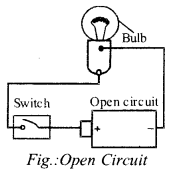
Question 4.
State the differences between an open circuit and a closed circuit.
Answer:
In closed circuit the switch remains in ON position and electric current flows in the circuit while in open circuit switch remains in OFF position and current does not flow in the circuit. In closed circuit the appliance works and in open circuit the appliance does not work.
Question 5.
What are conductors and insulators? Give three examples of each.
Answer:
Conductors : Substance through which electricity can flow easily are known as conductors of electricity.
Example : copper, iron, silver.
Insulator : Substances through which electricity cannot flow easily are known as insulators of electricity.
for example – Plastic, glass, wood.
Long Answer Type Questions
Question 1.
What is flow of electric current? Explain with a diagram.
Answer:
The transfer of charges in a conducting wire is called flow of electric current. When in any circuit a bulb is connected to switch and battery in proper combination, then electric current flows through the circuit and bulb starts to glow.
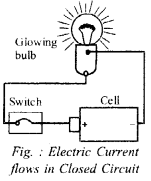
Question 2.
Take a used cell and break it to open apart. Now examine and describe each and every contact of the cell in detail.
Answer:
A dry cell consists of a graphite rod surrounded by a moist paste in a metal cylinder. This paste may be of ammonium chloride and manganese dioxide, depending on the type of battery. This rod and paste are wrapped in paper or cardboard and sealed into a metal cylinder which is made of zinc. The graphite rod upper end works as positive terminal, while metal cylinder works as negative terminal.
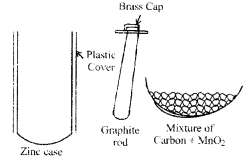
Question 3.
Describe the structure of an electric bulb used in torches. Also draw its well labelled diagram.
Answer:
A torch bulb is made up of spherical glass which is attached to a metallic base. There is a filament inside the bulb. The filament is attached to two wires. One of the wires is attached to that metallic base of the bulb, another wire is attached to the side of the metallic portion of the bulb. The side of the bulb is the negative pole while the bottom is the position. Torch bulb live pole.
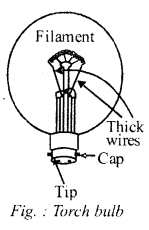
Practical Work
Question 1.
Find out about the life of the invertor of electric bulb – Thomas Alva Edison, and write it your note – book.
Answer:
Thomas Alva Edison was born in Milan, Ohio and grew up in Port Human, Michigan. Edison began his career as an inventor in Newark New Jersey with the automatic repeater and his other improved telegraphic devices, but the invention that first joined him wider notice was the phonograph. He made a series of inventions. Some other famous inventions with which the name of Edison is associated are as follows Vote recorder printing telegraph and carbon telephone transmitter Edison had made over 1000 experiments before he succeeded in inventing the electric bulb. Edison died on 18th October 1931.
Question 2.
Take a damaged torch and observe it from inside. Draw its diagram in your note book.
Answer:
A torch is made up of a cylindrical casing. The casing can be metallic or non – metallic. The cells are kept inside the casing. The bottom of the casing has a spring which is attached to the metallic wire. The spring helps in keeping the cells snugly fit in place. The metallic wire is attached to the negative terminal of the holder. The positive end of the holder touches the positive terminal of the cell at top. The bulb fits inside the holder.
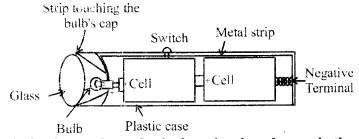
Question 3.
Alessandro volta is the scientist who made the first cell, that cell is called the voltaic cell, after his name. Take a pot of glass, fill it with water and add common salt in it to make a common salt solution. Now insert a copper and a zinc rod (electrodes) into it (make sure that they do not touch each other.) Now connect a 1.5 volt electric bulb or a LED through the two rods and pass the current. Does the bulb or LED light up? Now repeat the same activity by taking a plastic container and filling that with cow dung or mud from the field and inserting the same rods again.
Answer:
Yes, bulb starts to glow. Students should perform this activity’ yourself.
Other Important Questions
Multiple Choice Questions
Question 1.
The appliance which is not operated by electricity
(a) bridge
(b) electric bulb
(c) hand fan
(d) T.V.
Answer:
(c) hand fan
Question 2.
The flow of electric current is from
(a) positive end to negative end
(b) negative end to positive end
(c) sometimes from negative end and sometime from positive end
(d) none of the above
Answer:
(a) positive end to negative end
Question 3.
In torch the positive terminal is at
(a) bottom of the cell
(b) in upper part of brass cap
(e) in plastic cover
(d) anywhere
Answer:
(b) in upper part of brass cap
Question 4.
The conducting substance is
(a) iron nail
(b) plastic refill
(c) wood
(c) all of these
Answer:
(a) iron nail
Fill in the blanks
1. ……….. is very important for our daily life
2. The thin w ire inside the bulb is called the …………. .
3. Cell has ……….. terminals.
4. When electric current is produced from, the filament of the bulb the light is ………… .
Answer:
1. electricity
2. filament
3. two
4. emitted
Very Short Answer Type Questions
Question 1.
Write the name of two electric appliances which operate by electricity.
Answer:
- Cooler
- Washing machine
Question 2.
What is power house?
Answer:
An electricity distribution center from where we got electricity.
Question 3.
When there is not electricity, then name two appliances used by us.
Answer:
- Torch
- Inverter
Question 4.
Does generator produce electricity?
Answer:
Yes, a generator can generate electricity.
Question 5.
Why we use switch in each appliance in home?
Answer:
To on and off the appliances.
Short Answer Type Questions
Question 1.
Draw labelled diagram of a cell.
Answer:
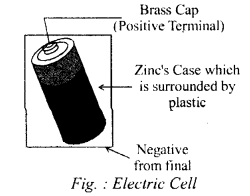
Question 2.
Make a list of appliances based on electricity in your home.
Answer:
Electric Appliances :
- Television
- Fridge
- Radio
- Electric press
- Microwave
- Washing machine
- Compact disc player
- Electric bulb
- Tube light
- Vacuum Cleaner
Long Answer Type Questions
Question 1.
What are conductors and insulators of electricity? Give examples.
Answer:
Electric conductor : Substances through which electricity can flow easily are known as conductors of electricity.
Example : Iron, silver copper, NaCl solution, graphite, electrolyte solution.
Non – Conductor of electric : Substances through which electricity cannot flow easily are known as insulator of electricity.
Example : Dry wood, non metals such as mica, pure water glass, plastic, rubber etc.
We hope the RBSE Solutions for Class 6 Science Chapter 14 Electric Circuits will help you. If you have any query regarding Rajasthan Board RBSE Class 6 Science Chapter 14 Electric Circuits, drop a comment below and we will get back to you at the earliest.